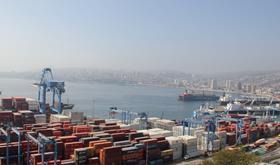
Given the rapid growth in Chilean fruit exports, and given that more than half the fruit exported from Chile travels out of the port of Valparaiso, it is unsurprising that major expansion works, envisioned and planned by Valparaiso’s Port Authority (EPV), are underway at the port.
“We are a small port, but we move a lot of containers,” said Tomas Serrano of TPS, which manages Valparaiso terminal 1. This size demands a high level of efficiency, for which Zeal, which controls the flow of trucks into the terminals, and equally performs produce inspections, is responsible.
So small is the port, in fact, that containers are frequently stacked six containers high, instead of the four common to most ports.
“We have 15ha of space here,” he said. “30ha is normal for most ports. We are limited because the city is right next to us.”
As the fruit industry increasingly moves toward larger container vessels – which are easier to load, not to mention faster and safer – ports like Valparaiso must expand in order to remain competitive.
“We are going to build an extension to the port of a further 120m,” said Serrano. “At the moment we can operate two vessels of 300m simultaneously, but vessels are getting bigger so this extension is essential. In one year, it will be complete.”
Currently, the terminal boasts five gantry cranes – two Panamax and three post-Panamax. The two Panamax cranes are due to be replaced by three post-Panamax, giving the terminal six in total.
“The oldest cranes can’t handle the larger vessels that operate now,” said Serrano. “In the future we believe there will be more larger vessels, so we are moving with the times.”
Terminal 2, which is run by TCVal and mostly handles breakbulk loads at present, the majority of which is fruit, is equally intent on keeping with the times.
“Reefer lines don’t come here as we don’t have any gantry cranes,” said TCVal’s Tomas Lauer. “So we are planning an expansion of 725m by 120m, at a cost of US$500m, complete with all the latest machinery. We will have five gantry cranes when it is finished, so we will no longer be just a bulk terminal. There is some opposition to the works from locals, but the project will create 3,000 jobs, directly and indirectly, in an area that badly needs them. If all goes well, we will start construction in March 2016.






No comments yet